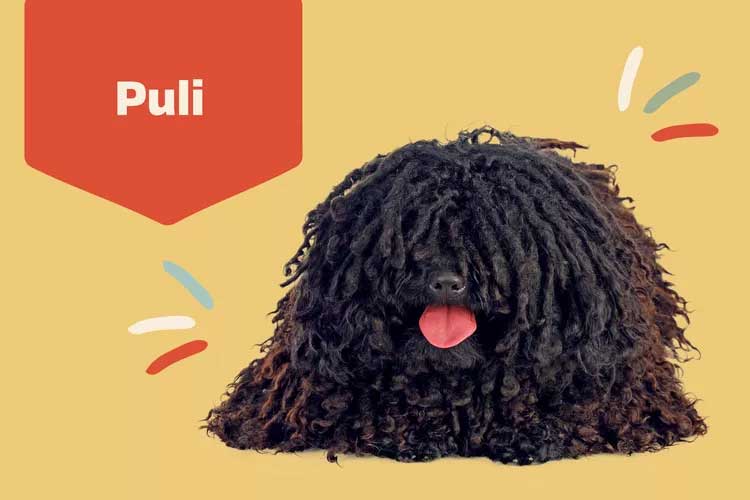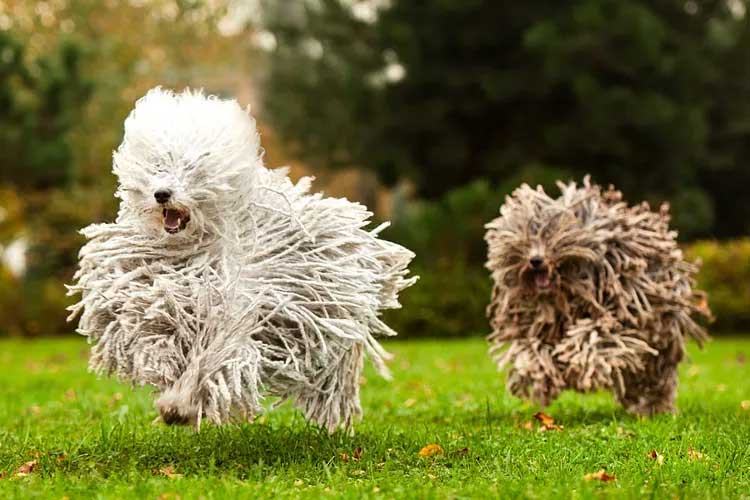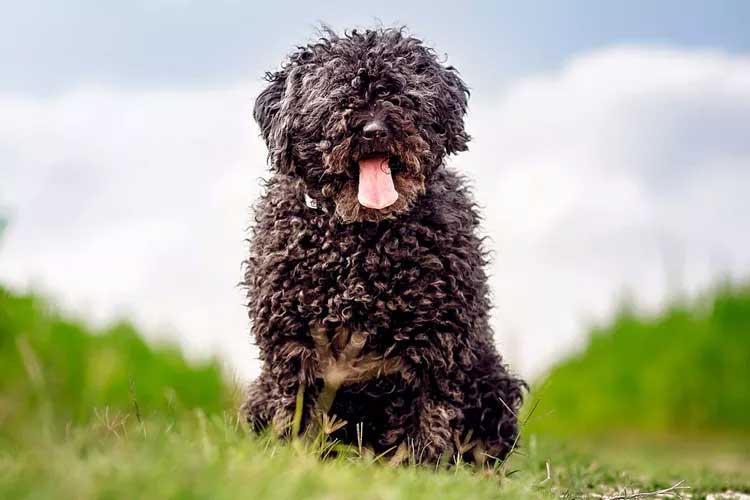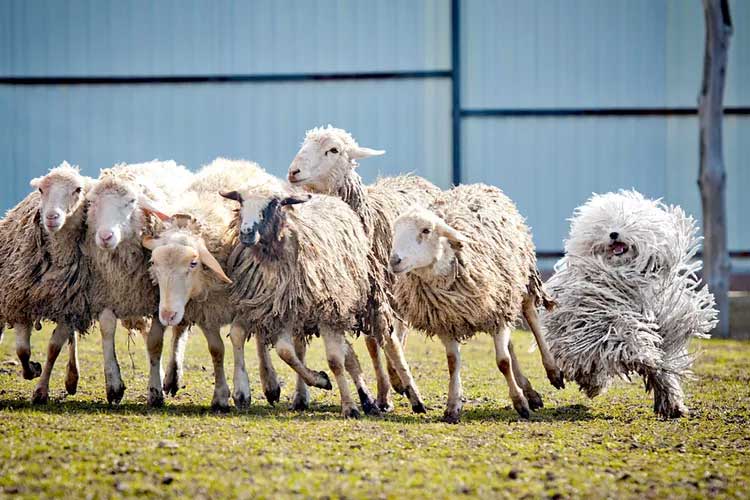The puli is an intelligent, energetic, adaptive, and happy dog that is loyal to her family and has a strong desire to please her favorite people. Learn more about caring for this corded Hungarian pup.

Puli Overview
| OFFICIAL NAME | Puli |
| COMMON NAME | Puli |
| PET HEIGHT | 16 to 17 inches |
| PET WEIGHT | 25 to 35 pounds |
| LIFESPAN | 10 to 15 years |
| GOOD WITH | children, families |
| TEMPERAMENT | outgoing, playful, willful |
| INTELLIGENCE | high |
| SHEDDING AMOUNT | infrequent |
| EXERCISE NEEDS | high |
| ENERGY LEVEL | active |
| VOCAL LEVEL | when necessary |
| DROOL AMOUNT | low |
| BREED GROUP | herding |
| BREED SIZE | medium (26-60 lbs.) |
| COAT LENGTH | curly, long |
| COLORS | black, gray, white |
| OTHER TRAITS | apartment-friendly, cold weather tolerant, easy to train, good hiking companion, requires lots of grooming, strong loyalty tendencies, tolerates being alone |
Pulik (the plural of puli) are smart, energetic, playful dogs who have a funny sense of humor and are incredibly loyal to their families. Standing between 16–17 inches at the shoulder and weighing between 25–35 pounds, they are compact dogs but agile and light on their feet, earning their reputation—and breed standard—as "acrobatic."
Bred to be independent thinkers and problem-solvers, the puli needs to be active mentally and physically, and she does well with owners who keep her engaged. Because she can be easily trained, a puli typically excels in performance activities such as agility, herding, rally, and obedience. Once well-socialized, according to the Puli Club of America Inc. (PCA), she makes for a terrific therapy dog.
When you're out and about, her cords may attract long looks from passers by—there aren't too many pulik in the U.S., so yours may be the only one at your local dog park.
Appearance
When you see what looks like a mop or shag rug bouncing around, you know you're looking at a puli. A puli's double coat rarely sheds and is made up of naturally occurring cords (sometimes referred to as dreadlocks) from her head to tail. These cords reach all the way to the ground and can be black, white, or gray.
"Many people are initially attracted to the puli because of its unique coat," says Barbe Pessina, who has 45 years of experience with the puli breed and is owner of Moonshadow pulik. "It's important to know that the coat also makes it a high-maintenance breed if you want to have a fully corded puli."
Pulik are often confused for another corded Hungarian breed, the komondor. And while there are a lot of similarities between these two mop dogs, you can tell if a pup is a komondor vs. a puli by her size and color. Komondors are much larger, and the puli's coat comes in more colors than the always-white komondor.
Temperament
Faithful, highly intelligent, alert, happy, and playful are words that go hand-in-hand with a puli personality and are part of what makes her a terrific part of the family."The puli breed originated as a herding breed of dog, and they tend to have strong ties with their owners," says Emily Wilson, DVM, veterinary expert with Fuzzy Pet Health. "As a breed, they are typically very family oriented as well as very smart and active."
Though lovebugs with their pet parents and family members, pulik are typically suspicious, watchful, and reserved around strangers. Socializing a puli puppy from an early age will help her grow to be comfortable when meeting new people.
Because they are just so smart and spunky, pulik might be better suited for experienced dog owners who can stick to a consistent training routine.
"Too many first-time dog owners will make all the mistakes of treating them like a fluffy puppy, allowing them to do what they want, and then not being able to turn the behavior around after," Pessina says.
But that intelligence does come with a lot of benefits: "I'm convinced the puli can look into the soul of their owner," Pessina says. "They intuitively know when you're happy, when you're sad, and when you're mad. … In many cases, once you've been owned by a puli no other dog will do. We have a saying in the breed: 'It's not a dog—it's a puli.'"
Living Needs
When it comes to her ideal home, the puli is pretty adaptable. As long as she receives plenty of exercise and attention, she can do well just about anywhere—even in a New York City apartment."All dogs need adequate exercise to be healthy and sound of mind," Pessina says. "A big yard doesn't necessarily correlate to exercise."
She says pulik need to be introduced to cats and other dogs during puppyhood so they learn how to get along with any furry siblings. "That said, they are good at home, but in a strange environment they prefer to ignore dogs they do not know," Pessina says.
As a working dog, it's no surprise that pulik like to stay active and do best with families who are always on the go.

"[Pulik] require mental and physical exercise and stimulation to thrive, and they would be best suited to a very active family who understands their higher drive nature," Wilson says. "They tend to be very athletic and excel in many dog activities including agility, herding, and obedience."
These pups will happily join you for evening strolls around the block, morning jogs, or a weekend hiking trip.
Care
One thing to know before bringing home a puli puppy: caring for her coat takes quite a bit of maintenance. Her undercoat is wooly and the outer coat is coarse and wavy, and together this double coat naturally creates the long cords the breed is known for. It's up to you to decide when she's a puppy whether you'll grow the cords out or opt for a brushed, uncorded coat instead.If you choose to embrace those doggy dreadlocks, begin separating the cords when your puli is about eight to 10 months old to prevent matting. You'll need to continue doing this as she matures. It can take five years for a fully corded coat to reach the ground and give your pup her signature 'do.
If a brushed, uncorded coat is more your pup's style, weekly brushing is required. But don't forget—you're going for a shaggy dog look, not something immaculate.
If she's active outside (running on a beach or hiking through the woods) she may need to be bathed more often than if she's cuddling with you on the couch. Whenever it's time for a bath, just be sure to give yourself plenty of time because it can take a long time to thoroughly rinse and dry her cords, according to the PCA. You'll need to squeeze (rubbing can form mats!) excess water from her fur. It's also important to get her 100-percent dry, as mildew can develop between her cords. And if a trim is in order, a bath is the best place to do it because the cords stretch a bit when wet.

As with all dogs, take the time at home to ensure your puli's ears are clean, her nails are trimmed, and her teeth are brushed often.
Considered one of the most intelligent dog breeds, a puli can be easily trained to follow cues. But because of her smarts, a puli won't be happy with the same training routine every day. Pessina says training requires some degree of creativity and flexibility.
"The best way is from the start as a puppy by giving them one command and making them do it," she says. "For example, sit, and place them in a sit position and praise like crazy. If you say 'sit, sit, sit' and on the tenth time the puli sits, you've just taught them they can respond when they feel like it."
Consistency, praise, and rewards for good behavior are vital for training success. Like all dogs, positive reinforcement training throughout a puli's life will help her be polite and well-behaved.
Health
Pulik have a lifespan of 10–15 years, and, as with all breeds, they do have a few health concerns to be aware of:Hip dysplasia: A condition where the hip joint doesn't develop properly, leading to an unstable joint. If left untreated, hip dysplasia can cause osteoarthritis.
Patellar abnormalities
Hereditary eye disorders
Degenerative myelopathy: A debilitating progressive mobility disorder in the spinal cord.
"Additionally, owners should be aware that their coat can be kept as 'corded' or 'brushed out,'" Wilson says. "If their coats are not maintained with proper breed-required grooming and maintenance, they may be more prone to skin irritation or infection."
Wilson says reputable puli breeders should be testing the puppies' parents for potential hip dysplasia and patellar disorders using radiographs and OFA or PennHIP screening. She also advises eye exams to help minimize the likelihood of hereditary eye diseases being passed along to puppies. Additionally, degenerative myelopathy, which is a debilitating progressive mobility disorder, can be screened for using a DNA test.
If you suspect your puli puppy is developing any of these conditions, be sure to consult your veterinarian. Aside from these potential conditions, your puli should visit the vet for regular checkups and vaccinations.

History
The puli was introduced in Hungary about 1,000 years ago, according to the PCA, though some believe the breed dates back as early as 4500 B.C. Either way, throughout history the puli has worked with shepherds to herd flocks of sheep and farmers to watch over cattle and protect farmland.The first puli crossed the pond and came to the U.S. in the mid-1930s, and the breed was registered in the American Kennel Club in 1936. Less than 20 years later, the Puli Club of America was established in 1951.
Fun Facts
A puli named Sprite starred in a 2015 Dr. Pepper TV commercial, "Always Be One of a Kind."Facebook founder Mark Zuckerberg and his wife Priscilla Chan have a puli named Beast.